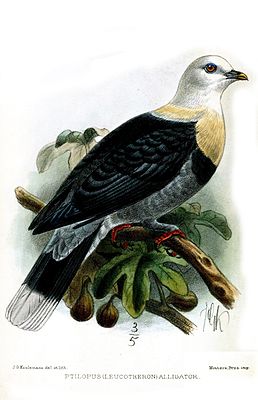Gray-bellied fruit pigeon
| Gray-bellied fruit pigeon | ||||||||||
|---|---|---|---|---|---|---|---|---|---|---|

Gray-bellied fruit pigeon ( Ptilinopus alligator ) |
||||||||||
| Systematics | ||||||||||
|
||||||||||
| Scientific name | ||||||||||
| Ptilinopus alligator | ||||||||||
| Collett , 1898 |
The gray-bellied fruit pigeon ( Ptilinopus alligator ) is a monotypical species of fruit pigeons . It occurs exclusively in the north of the Australian continent. On their distribution in the catchment area of the Alligator Rivers , the epithet alligator back.
The gray-bellied fruit pigeon is considered to be harmless in its population ( least concern ).
Appearance
The gray-bellied fruit pigeon reaches a body length of 34 centimeters. It is about the size of a wood pigeon . There is no such thing as gender dimorphism .
Appearance of the adult birds
Both sexes of the gray-bellied fruit pigeon have a white head, the neck is overlaid with yellowish isabel colors. The coat is black with a slight metallic sheen. The wing covers and the wings are black, the outer flags of the hand and arm wings have a dull greenish sheen. The back is blackish, with the individual feathers having a gray base. The rump is ash gray. The tail feathers are black with a dull greenish sheen on the outside flags. In the last third the tail feathers are silvery white.
The chin, throat and ear covers are white. The chest is white with a yellowish-isabel tone. The chest is separated from the stomach by a wide, slightly shiny band against the stomach. The belly is dark gray. The under tail-coverts are light gray with white hems on the outer flags. The iris is chestnut brown to dark red. The featherless skin around the eye is grayish-white, greenish-blue, or pale green. The beak is greenish yellow. The feet are bright red.
Appearance of the young birds
Compared to the adult birds, juveniles have a grayer head, the neck is very finely banded with gray crossways. The feathers on the upper side of the body and the wings have partly narrow pale yellow hems. The iris is dark brown to yellow with a gray inner ring. The featherless skin around the eye is pale green, the beak is blue-gray. The feet are pink to pale crimson.
Possible confusion
The distribution area of the gray-bellied fruit pigeon overlaps with that of the two-color fruit pigeon . It is the only other species of pigeon in the distribution area of the gray custom fruit pigeon, which also has black and white body plumage. The two-colored fruit pigeon is not only significantly larger, but also has a higher proportion of white in its plumage. It is almost completely white on the underside of the body.
Distribution area and habitat
The gray-bellied fruit pigeon is limited in its distribution to Arnhem Land and the Northern Territory bordering on Arnhem Land . One of the main areas of distribution is the Kakadu National Park . Arnhem Land is on the north coast of the continent, about 200 kilometers east of the city of Darwin . It extends from Port Roper on the Gulf of Carpentaria to the East Alligator River , where it borders Kakadu National Park. In this area, the gray-bellied fruit pigeon occurs only in individual regions. Although it is not found frequently in the entire range, its population is not endangered.
The gray-bellied fruit pigeon inhabits dense evergreen monsoon forests in this range, such as those found in the gorges and valleys of Kakadu National Park and Arnhem Land. The population is densest in the interior of the respective forest areas. In the forests along the East Alligator River and in the eucalyptus forests of the lowlands, on the other hand, the gray-bellied fruit dew is rare.
Way of life
The gray-bellied fruit pigeon lives solitary or in pairs. It is only occasionally found in flocks of 20 to 30 birds that take pictures in the vicinity of fruit-bearing trees. The gray-bellied fruit pigeon is not particularly shy and, sitting quietly in the crown of a tree, tolerates people coming within a few meters. If it then flies up, a loud flapping of wings can be heard. The gray-bellied fruit pigeon rarely comes to the ground. She usually does this to drink.
The breeding season falls in the months May to November and thus falls in the late dry season or in the early rainy season. The nest is a pigeon-typical platform made of small branches that is erected a few meters above the ground. Gray-bellied fruit pigeons lay a single egg.
literature
- David Gibbs, Eustace Barnes and John Cox: Pigeons and Doves - A Guide to the Pigeons and Doves of the World . Pica Press, Sussex 2001, ISBN 90-74345-26-3 .
- Alois Münst and Josef Wolters: Tauben - The species of wild pigeons , 2nd expanded and revised edition, Verlag Karin Wolters, Bottrop 1999, ISBN 3-9801504-9-6 .
- Gerhard Rösler: The wild pigeons of the earth - free living, keeping and breeding . M. & H. Schaper Verlag, Alfeld-Hannover 1996, ISBN 3-7944-0184-0 .
Web links
- Ptilinopus alligator inthe IUCN Red List of Threatened Species 2016.1. Posted by: BirdLife International, 2016. Retrieved December 19, 2016.
Single receipts
- ↑ Ptilinopus alligator in the IUCN Red List of Threatened Species 2016.1. Posted by: BirdLife International, 2016. Retrieved December 19, 2016.
- ↑ a b Gibbs, Barnes and Cox: Pigeons and Doves , p. 461.